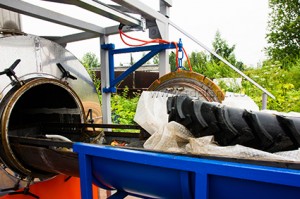Pyrolytic process description
Pyrolysis is defined as thermal conversion process of hydrocarbon waste in the absence of air. The main products resulted from hydrocarbon processing are syngas, liquid oil and solids (char, carbon black, metal).
The pyrolytic process, also referred to as cracking, is outlined as following:
- Raw materials are fed to the reactor, where heated by burner;
- The temperature in the reactor is controlled and smoothly increased;
- Pressure rise defined the beginning of the thermal decomposition process;
- When the process is stabilized, the burner is switched to the pyrolysis gas;
- The cooling of the mixture is carried out in heat exchanger and then is directed to gas-liquid separator;
- The oil product is drained to the storage tanks;
- Dry residue is discharged by screw conveyor or rests in the chamber and is removed after cooling.
Find more about TDP-2 plant process description.
Outputs
Uunsaturated hydrocarbons (ethylene, propylene, butadiene and other alkanes) derived from pyrolytic processing can be used in production of plastics, rubber and other synthetic materials. In relation to the capabilities of Thermal Decomposition Plants the process outputs are:
- pyrolysis gas is used at the plant for heating to satisfy system’s energy needs or can be flared;
- solid residue (carbon black, char) is used in construction, can be added to the coal bricks, road, carpet and roofing material;
- synthetic oil, can be used in boilers or refined to fractions resulted in diesel, gasoline, heavy oil;
- heat of the plant is recovered and used for local heating;
- distilled water (in case of brine based drilling sludge processing) is used as drilling solution preparation or drinking water
Benefits presented by pyrolysis technologies:
- Alternative energy recovery;
- Full control over the process;
- High energy efficiency;
- Negligible emissions;
- Mobility of the systems;
- Low energy consumption;
- Cost – efficient process.
When using the material or any part of it the link to the website (www.tdpplant.com) is required.






